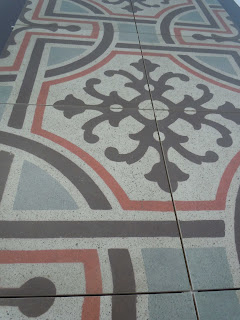VERSION EN ESPAÑOL
As we have said in previous entries of decorational, we will try to have a deeper approach to the materials we write about, showing not only their decoration possibilities, but also other characteristics that help you to make an appropiate selection when choosing a material to be used in your project.
As we have said in previous entries of decorational, we will try to have a deeper approach to the materials we write about, showing not only their decoration possibilities, but also other characteristics that help you to make an appropiate selection when choosing a material to be used in your project.
That's why we will write numerous entries with technical information about materials, trying to know them better.
In our last entry we introduced a ceramic material with inkjet surface decoration, and that's why we think it's interesting to explain the different methods used in ceramics industry to decore tiles, that let de producers the development of new models and ceramic solutions:
Curtain application
Ceramic glaze falls from the top of a metalic bell to form a continious curtain, and the tiles pass through it show ther are fully covered by a layer of glaze which thickness depends on the speed of the tiles in the production line. This method is used to obtain tiles with solid colors.
In our last entry we introduced a ceramic material with inkjet surface decoration, and that's why we think it's interesting to explain the different methods used in ceramics industry to decore tiles, that let de producers the development of new models and ceramic solutions:
Curtain application
Ceramic glaze falls from the top of a metalic bell to form a continious curtain, and the tiles pass through it show ther are fully covered by a layer of glaze which thickness depends on the speed of the tiles in the production line. This method is used to obtain tiles with solid colors.
Serigraphy
This system has been used for ceramic decoration since about 1960. It consists of a framework that fixes a perforated fabric (silk-screen display) for color to pass through these holes.
The ceramic glaze is extended on the screen by a mechanical element, so it passes through the holes leaving the color over the tile only where the holes are. Different colors can be applicated using successive screens with different decorations. All tiles produced by this system have the same decor.
Rotogravure
This decoration system uses a roller in whose surface has been made small holes that define the pattern to be transferred to the tile. These holes are created by lasers, which are small and allow for greater definition than serigraphy.
The pigment is deposited on top of the roll and extended through a dispenser that fills all the holes and clean the surface. When the roll comes into contact with the tile, the pigment passes from the holes to the surface of the piece, forming the desired decoration.
Tiles obtained by this method may have different decorations depending on the roller size -usually 1.30 m2- and the position of contact contact between the roller and each tile.
Inkjet printing
The development of new printing systems and ceramic glazes has let ceramic producers to include in their production chains electronic decoration machines which can print photografic pictures on the ceramic tiles, as it is done on other different materials.
As in a domestic inkjet printer, microscopic drops of different colors are sprayed to the tile's surface, conforming the final picture. Pigments used are similar to traditional ceramic glazes, so the ceramic tiles obtained whith this decoration technology keep all their technical characteristics without change, so they can be used in domestic or commercial areas, even as a floor, without trouble.
A solution that uses this technology is emotile by Ceracasa, which we have written about in the previous entry of decorational (link: Custimozed ceramics: emotile by Ceracasa).
We hope this information, as that we can write in the future, will help you to understand how materials are made, so you can make a better selection of them for your projects.
We will be waiting for you in the next entry of decorational.
Pictures used in this entry have been obtained from "La Guía de la Baldosa Cerámica"














